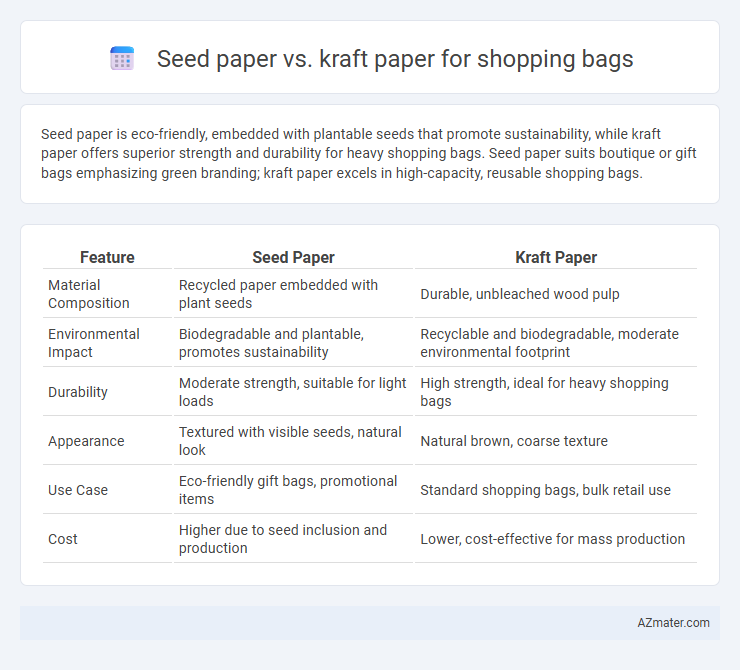Seed paper is eco-friendly, embedded with plantable seeds that promote sustainability, while kraft paper offers superior strength and durability for heavy shopping bags. Seed paper suits boutique or gift bags emphasizing green branding; kraft paper excels in high-capacity, reusable shopping bags.
Table of Comparison
| Feature | Seed Paper | Kraft Paper |
|---|---|---|
| Material Composition | Recycled paper embedded with plant seeds | Durable, unbleached wood pulp |
| Environmental Impact | Biodegradable and plantable, promotes sustainability | Recyclable and biodegradable, moderate environmental footprint |
| Durability | Moderate strength, suitable for light loads | High strength, ideal for heavy shopping bags |
| Appearance | Textured with visible seeds, natural look | Natural brown, coarse texture |
| Use Case | Eco-friendly gift bags, promotional items | Standard shopping bags, bulk retail use |
| Cost | Higher due to seed inclusion and production | Lower, cost-effective for mass production |
Introduction to Eco-Friendly Shopping Bags
Seed paper shopping bags integrate embedded seeds that germinate when planted, promoting sustainability by reducing waste and encouraging plant growth. Kraft paper shopping bags are made from unbleached, natural wood fibers, offering durability and biodegradability for eco-conscious consumers. Both materials support environmentally friendly practices by minimizing plastic use and enhancing recyclability in everyday shopping solutions.
Understanding Seed Paper: Features and Benefits
Seed paper, embedded with biodegradable seeds, transforms used shopping bags into plantable items, offering an eco-friendly alternative to traditional Kraft paper bags. This innovative material promotes sustainability by reducing waste and encouraging greenery as the embedded seeds germinate when planted. Unlike Kraft paper, seed paper provides dual functionality--serving as a durable shopping bag and a green initiative that supports environmental conservation.
What is Kraft Paper? Key Characteristics
Kraft paper is a durable and coarse paper made from chemical pulp produced through the kraft process, renowned for its high strength and tear resistance, making it ideal for shopping bags. Its natural brown color and rough texture are key characteristics, providing an eco-friendly, recyclable option that supports heavy-duty use. Kraft paper's water resistance and longevity further contribute to its popularity in sustainable packaging solutions, especially for retail applications.
Environmental Impact: Seed Paper vs Kraft Paper
Seed paper is biodegradable and embedded with seeds that can grow into plants, significantly reducing waste and promoting reforestation, while kraft paper is recyclable, strong, and derived from wood pulp but typically requires more energy and chemicals during production. Seed paper offers a dual environmental benefit by supporting plant growth and minimizing landfill contribution, whereas kraft paper's environmental impact depends heavily on sourcing and recycling practices. Both materials serve eco-friendly purposes, but seed paper's ability to transform into living plants advances sustainability beyond just recyclability.
Strength and Durability Comparison
Seed paper offers eco-friendly benefits but typically lacks the high tensile strength and durability of kraft paper, making it less suitable for heavy shopping bags. Kraft paper, produced from strong wood pulp fibers, exhibits superior tear resistance and load-bearing capacity, ideal for reusable or heavier shopping bags. For applications demanding long-lasting strength and durability, kraft paper remains the preferred choice over seed paper.
Customization and Design Options
Seed paper offers unique customization options by embedding biodegradable seeds within the paper, allowing for eco-friendly branding and interactive designs that promote sustainability. Kraft paper provides versatile design possibilities through various printing techniques, including embossing and foil stamping, enabling bold logos and intricate patterns with a rustic, natural aesthetic. Both materials accommodate tailored shapes and sizes, but seed paper stands out in blending functionality with environmental storytelling in custom shopping bags.
Cost Analysis: Seed Paper vs Kraft Paper Bags
Seed paper bags generally incur higher production costs due to embedded seeds and specialized manufacturing processes, making them pricier than traditional kraft paper bags. Kraft paper bags offer a cost-effective option as they are made from readily available recycled fibers and involve simpler mass production techniques. For businesses prioritizing budget-conscious packaging, kraft paper bags often provide a more economical solution compared to seed paper alternatives.
End-of-Life: Composting and Reusability
Seed paper offers superior compostability, breaking down naturally and enriching soil with embedded seeds, making it an eco-friendly choice for shopping bags intended for single use and easy disposal. Kraft paper is durable and recyclable but less biodegradable, often requiring industrial composting facilities and offering limited compostability compared to seed paper. In terms of reusability, kraft paper bags are more resilient and suitable for multiple uses, while seed paper bags typically degrade faster, limiting their reuse potential but enhancing their end-of-life ecological benefits.
Consumer Perceptions and Market Trends
Seed paper shopping bags are perceived as environmentally innovative, appealing to eco-conscious consumers seeking sustainable packaging solutions that can be planted to grow greenery. Kraft paper bags maintain strong popularity due to their durability, cost-effectiveness, and natural appearance, resonating with consumers valuing practicality and traditional aesthetics. Market trends reveal a growing demand for seed paper as brands emphasize zero-waste initiatives, while kraft paper remains a staple due to its recyclability and widespread availability.
Choosing the Right Material for Your Shopping Bags
Seed paper offers an eco-friendly and biodegradable option for shopping bags, promoting sustainability through plantable embedded seeds that grow into flowers or herbs. Kraft paper provides a durable, recyclable material known for its strength and affordability, making it ideal for heavy-duty shopping bags. Selecting the right material depends on your brand's environmental goals and the bag's intended use, balancing seed paper's innovative green appeal with Kraft paper's practical resilience.

Infographic: Seed paper vs Kraft paper for Shopping Bag
 azmater.com
azmater.com